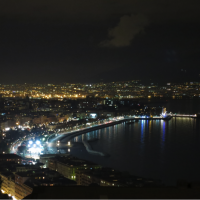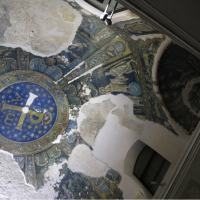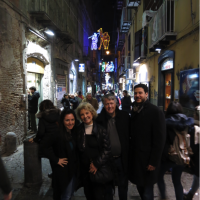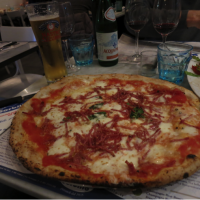CLICK HERE to sign up for our Newsletter!
call us 713-405-1193
call us 713-405-1193
Blog
Summer ACT Course – Starts July 20th
July 01, 2015
by All-in-One Academics
0 Comment
We have an intensive summer ACT course beginning on July 20th. The class will meet Monday/Wednesday/Friday for two weeks, three hours per day, for 18 hours of coursework. There will also be a mock test on Sunday, August 2nd. This class will be led by our Senior Test Prep Consultant, Errolynn Zetar.
For over 10 years, Errolynn has dedicated herself to test preparation. She outpaces the competition with a 7 point score improvement, and her students actually ENJOY working with her. Errolynn turns the drudgery of test prep into fun and transforms mediocre test scores into college admissions gold. She rarely teaches group classes, but because of summer’s rare freedom, she is taking on a limited number of students for an Elite 18-hour ACT Immersion Course. We are capping the class at five students to make sure each student receives individual attention but also benefits from the interactions that can only occur in a group setting.
We are happy to answer any questions you may have. If you would like references about Errolynn’s unique expertise, we will provide them, send us an email at info@allinoneacademics.com.
Summer ACT Course
Dates: Monday/Wednesday/Friday
July 20th, 22nd, 24th and July 27th, 29th, 31st, plus a test on August 2nd
Location: 1973 West Gray, Suite 17, Houston, TX 77019
Cost: $1,500
To sign up, please click here. This is a special summer opportunity to take advantage of!
May 16th – Free Workshop: 5 Secrets to College Admissions Gold
It’s true: summer will be here soon. Before you get swallowed up in end of the school year activities and summer vacation planning – join us for a free college admissions information session! On Saturday, May 16th, our president, Jessica Givens, will be delivering her engaging and informative presentation “Five Secrets to College Admissions Gold” at our office on West Gray.
Too many parents, students and counselors are operating with out-dated assumptions about what works and are blind-sided by often-avoidable rejection letters. Join us to learn about how to navigate the ever-changing college admissions process. This session is geared toward parents of students between eighth and eleventh grade but anyone is welcome.
Jessica Givens / All-in-One Academics
Five Secrets to College Admissions Gold
Saturday, May 16th from 1:00pm – 2:00pm
River Oaks Shopping Center, Second Floor
1973 W. Gray Suite #17 Houston, TX 77019
We have had a great response to this presentation in years past – please join us! The information session will also include a brief discussion about our upcoming College Application Crash Courses for high school juniors. Space is limited so please let us know if you’ll be attending. To RSVP, send an email to may@allinoneacademics.com or call 713.405.1193. We hope to see you there!
Conquering College Workshop
We are happy to share a new workshop with graduating seniors who will be starting college in the fall: Conquering College!
Graduation from high school is really just the beginning – and many students would benefit tremendously from some no-nonsense guidance as they head off to school. We have all heard stories of good kids veering off track during their freshman year but when armed with some common sense information and a couple of useful tools before they get there, we think we can help make a successful freshman year more likely.
We will cover things such as:
– the importance of keeping in programs admitted to
– why not to drop your major
– how to keep any testing/timing accommodations they may have
– how to use May/Jan terms effectively
– how to supplement your coursework with Community College classes
– web-based tools to manage workload
– and more!
This workshop is free to attend and will be held on Sunday, May 31st at 1:00pm at our office on West Gray.
1973 West Gray
Suite 117
Houston, TX 77019
Space is limited, so to reserve a spot, please send an email to may@allinoneacademics.com.
High School Internships & College Admissions
Over the past several years, colleges have begun to look more for what we call an angular student. Gone are the days of being well-rounded and scattered in your interests. Now, they want to see a clear path – what students have done that back up their choice of major – which allows them to see how that student will fit into the overall puzzle of their incoming freshman class. So while the overall message is the same – stay busy, participate in extracurricular activities, and study hard – there is now a need for a bit more planning so that all of the pieces come together to tell a compelling story.
One great way to demonstrate interest in a particular field is through an internship. Learning the ropes of a local business has long been advised to high school students but as mentioned above, use care in choosing where to apply. Your choice should reflect your goals in college and beyond! Recently we contacted the admissions offices at a few schools that are popular with students we work with to hear what they had to say about high school internships – and here we’ll share their points of view with you!
At the University of Texas in Austin, TX, it is always important to remember that you are applying for a major. The official we talked to said specifically that if an internship supports the applicant’s major choice, it is more beneficial than a “random” internship. At UT, the internships are included as part of the resume in the application so make sure that you are able to help connect the dots of what your interests are, what experience you’ve gained, and where you see yourself heading in the future. While UT does engage in a holistic review, meaning each part of the application is reviewed and weighted evenly, the chance to elaborate on an internship in your resume that backs up your major selection is a huge opportunity and should not be wasted.
The admissions official at Vanderbilt University in Nashville, TN that we talked to said that internship experience can only help an applicant. The internship experience is included on their application within the extracurricular experience section and is evaluated as such. When reviewing the application, they’ll be looking to see what the student gained from the experience and how it makes them more balanced. Students have the opportunity to describe their internship in the extracurricular section so keep in mind that it is a chance to show what was learned at the internship and how it relates to major selection and future plans. The admissions team at Vanderbilt is trained in “positive advocacy” which means that they are not looking for reasons to deny a student, but are instead looking for reasons to accept. Show them and others why this internship experience makes you a better applicant!
With Spring right around the corner, now is the time to start making internship plans for summer! Many larger companies and organizations have formal internship programs with application dates on the horizon, so you’ll need to plan ahead. As you begin looking for the right opportunity for you, start by looking at your interests and what experience you already have. Are there any paths that you’ve already started creating for yourself that you can continue on? If not, try to think about possible majors or careers that you are interested in. Then, Google is your best friend! Look for companies and businesses in your area that you’d like to reach out to. You’ll meet new people, learn a whole lot, and help prepare yourself for college and your future career – start looking for your perfect internship today!
Feeling overwhelmed? This June, All-in-One Academics is launching our Career Academy program that helps pair students with internships in their desired field. The program consists of a three-week internship along with a professional development course that meets on Friday mornings. For more information about this exciting new program, click here.
New Workshop Available: Reading Comprehension
We are excited to share a new workshop with students in 7th and 8th grade looking to improve their reading skills! This workshop will not only develop reading fluency, vocabulary, and comprehension, but it is also designed to show students how reading can be fun and enjoyable. (Imagine that!) Students with high grades will learn to perfect their reading habits, while struggling students will learn new methods to overcome challenges.
We will utilize 5 different strategies that are proven to increase comprehension: Read Around the Text, KIM (Key Word, Important Information, Memory Cue) Vocabulary, Two-Column Notes, Reciprocal Teaching, and Sum it Up. Using these strategies, students will read a book “for fun” during the workshop. There will be no homework assignments; however, you may catch your child reading on his own as we progress!
Reading Comprehension Workshop: Part I
7th-8th graders
Saturdays from 12 – 2pm, Sundays from 5 – 7pm
6 sessions: February 28 & 29, March 7 & 8, SKIP MARCH 21 & 22 (Spring Break), March 28 & 29
We will meet at the All-in-One Academics space at 1973 West Gray.
This workshop is limited to 10 students.
The cost is $599.
Click Here to Register!
An Educational Trip – Athens and Its Environs
Exploring Athens and Its Environs:
When discussing educational travel, I can’t imagine a better destination than Athens and its surroundings. Why? Because it’s the cultural center of the Western world. While much of the world stagnated in barbarian practices, living in mud huts and clawing for survival, the Greeks strolled in the warm rays of the Mediterranean sun and dwelled on such luxuries as philosophy, art, and theater. Simply put, those pursuits were unheard of in the 5th century, B.C., pretty much everywhere except Greece. And, no one can argue that Athens, in particular, flourished, due to its fortunate leadership in the Greek naval victories over the Persians. And that’s why we started here.
For Jamil and me, this is our second trip to Athens. We came here the first time because we had families asking us about study abroad to Greece. Furthermore, parents, knowing my penchant for European travel, wanted me to plan senior trips for their children to Europe. How could I recommend Greece, a place that appears in American news primarily under riotous headlines, without seeing it for myself? Well, after one trip to Athens, during which we visited only Athenian cultural sites and Minoan historical sites in Crete, I was convinced: Greece was not only safe; it was also underrated. This was raw culture. People felt strongly, completely, unabashedly Greek. They may have been part of the European Union, but they were firmly Greek, first and foremost. I loved their schedule, their adherence to a lifestyle that once dominated the entire Mediterranean area but that has faded in Italy and Spain under the duress of modern economic expectations. Greece shows no signs of releasing its traditions, however. It’s enjoy life or bust. Furthermore, the cycle of each day in Athens is carried out under the watchful, ever present eye of the Acropolis, the crowning jewel of ancient Greece.
On our first trip to Athens, Jamil and I hired no guides. We used my previously held knowledge and the wisdom of TripAdvisor (plus some Rick Steves’ genius) to find our way through the ruins and the museums. This time, we vowed to do it differently because we realized that our readers, clients, and friends needed to know where to look and whom to call to gain genuine insight into the heritage of the Western world. To my dismay, finding a guide in Athens from the United States proved a major challenge. Even for an experienced, adventurous traveler like me, the options seemed confusing, undesirable, and, to make matters worse, inconsistently priced.
Most guides to the cultural heritage sites around Athens appeared to be taxi drivers. They have nice vehicles, definitely up to American luxury standards, but they lack something critical, a tour guide license. Therefore, it seemed like a poor option for history buffs like us. I have since had to eat my words because I actually met an awesome guy who owns one such company – to be discussed later. In any case, I was looking for something entirely reputable… Fortunately, I found it.
Tip #1: Hire a guide at the Athens Archaeological Museum
Our first full day in Athens, we went immediately to the archaeological museum. I thought I could probably lead the tour myself. After all, in preparation, I listened to The Great Courses: Classical Archaeology, by Dr. John Hale, an archaeologist trained at both Yale and Cambridge, who now runs the Liberal Studies program at the University of Louisville. Furthermore, I treated myself once again to the lectures of Dr. J. Rufus Fears in his Famous Greeks series, also offered through The Great Courses. So, on all fronts, I considered myself prepared to view, absorb, AND educate my parents. However, my plans changed happily for the better at the entrance to the museum, where a woman with a sunny disposition, named Andromache, sat next to a sign advertising tours of the exhibits.
For 50 euros, we hired Andromache’s services for an hour, and she wove her way through the halls she knew so well, taking us all the way from the Stone Age to the Hellenistic Era. I completely recommend this service, especially for families and/or groups, many of which include people with varying levels of background information and interest. Andromache can offer as little or as much insight as you want, turning an overwhelming trove of antiquities into a manageable, enjoyable, educational experience. One of the most fascinating sections with Andromache was a part of the museum that basically eluded us last time, the Mycenaean section. This time, we appreciated the detailed metalwork, and while I found the silver bull with gold horns the most beautiful, the hammered-gold death masks of two twin infants were probably more significant. Furthermore, with Andromache I learned that the famed Mask of Agamemnon (long known to be a misnomer) predates the Mycenaean times, roughly 1200 BC, by 400 years. That makes it an even more significant find than it was claimed to be. I know this may not fascinate everyone, but when you see it with Andromache’s explanations and when you realize that the faces represented before you passed out of existence 3600 years ago, the weight of history and its inescapable evidence of mortality is undeniable.
Tip #2: Do not miss the Antikythera mechanism
Believe it or not, this is an ancient computer. It calculated the positions of the sun and moon at any given date. It even had its own manual, inscribed on its metal door. You should read up on the Antikythera mechanism in advance, so that you understand what you’re seeing, unless you’re lucky enough to snag a guide at the entrance, like we were.
Tip #3: Pay special attention to the marble statue of Athena that is encased in glass
This is an ancient recreation of the chryselephantine (ivory) statue of Athena that once stood in the Parthenon. Imagine it 30 feet tall and clothed in gold. That’s how the piece really was when it held court in the interior of the Parthenon as the special icon of the temple. A vivid mental image of the statue will give you an even greater sense of the magnitude of the Parthenon’s value and importance to the city-state of Athens, which took its name from Athena herself. The statue represents the pride of the polis and the commitment of the Athenian people to the reverence of their patron goddess. It was probably the most significant statue in classical Athens, and the Roman conquerors found the cult statue of Athena so mesmerizing that Constantine had it shipped to Constantinople to show his power and add to the magnificence of his namesake city.
Tip #4: If you like your museum guide, ask for further tours
The guides at the museum are all thoroughly vetted for knowledge and communication skills, so they’re top-notch. BUT, they are not bound to the museum! They can go with you to the Parthenon, to Delphi, to the Peloponnese – you name it! We know because we hired Andromache after our amazing museum tour with her. She and her lovely husband drove us over to the Ionian coast of Greece to see the shrine of Greece on the 2nd of January. And that will be our next post!
Food recommendations so far in the trip:
- Café Abyssinia – This is a tiny gem tucked into the square of a flea market. The food is outstanding. Please allow us to recommend the house baked cheese dish, the moussaka, and the yogurt/honey/walnut dessert. While everything is outstanding, these were our highlights, in addition to the excellent service.
- To Steki To Ilia – Are you into grilled meats? Hopefully, you don’t mind the random, unannounced bit of (delicious) grilled kidney tossed in with your array of charred chops…If so, you’ll be fine here. For two years, Jamil and I talked about the lamb chops here at To Steki. We recalled the long walk along the metro, the sketchy exterior of the restaurant, the pile of fatty, tender meat that greeted us. The entire experience screamed anti-timid-tourist, and we loved every second of it. So, we had to go back. We needed the rawness of the ambience and the honesty of the food. There are no formalities; there is no English; there are no apologies for any lack thereof. Order the fava (pureed yellow split peas topped with red onions), the sausage, and the lamb chops. The Greek salad is probably great during warm weather. It was a bit flavorless and forgettable during the winter. Nostra culpa for ordering them at all.
- The Rooftop Bar/Restaurant at the Hotel Grande Bretagne – Even if you don’t wind up staying here – which you absolutely should, if it’s available – you must come to the bar. It’s gorgeous, the service is phenomenal, and the fare is wonderful. You can have an excellent martini alongside a trio of delicious ceviches, plus a flavorful pizza. If that’s not enough, come for the view. You will get a photo of the entire acropolis and an unbeatable panorama of Athens and Piraeus.
- Strofi – We spent New Year’s Eve here, and honestly, I was concerned that the food would not live up to the TripAdvisor reviews (I’ve been burned before). Strofi could not have been more perfect. The view was unparalleled, and the food was perfect from start to finish. We drank fruity Greek wine and ate such delicacies as haloumi cheese straight off the grill and lemony dolmas, plus garlicky gigantes beans. Our evening was punctuated with a major event – a performance at the microphone by one of our co-diners, Zozo Sapountzaki – which made the whole evening more glamorous and the memories more indelible. I have a sneaking suspicion this will not be our last New Year’s at Strofi. It was one for the books.
An Educational Trip – Naples Day 2
Second Day in Naples
We had a choice: save 250 euros and go by public train, or cough up the cash and go in a private car. We chose the latter. Even though we love color and local flavor, we just didn’t have time to screw around with countless stops on a regional, commuter train. If we had booked a couple of days of touring – one day in Pompeii and an additional day for a combined Herculaneum/Oplontis tour, the train would have been perfect. At the same time, my dad’s back would have given out if we had tried that, so there you go.
At 8:30 AM, we met Andrea at our hotel and headed out with him at the wheel. Normally, you would get a designated driver for such an excursion, but we made our decision to have a car at the last minute, so our car (a Mercedes E-class) would only fit 5 people, maximum. Driving through Naples is an experience, especially with a guy who normally drives a standard and who keeps hitting the brake like it’s a clutch. As we drove, we saw the port, where monstrous cruise ships deposit their swarms of tourists. They all emerge with a look of confusion, easy targets for Neapolitans. Looking at the port, I detected two important bits of reality. First, I saw why people badmouth Naples so unabashedly, calling it ugly and unsavory. If you only see the port area of Naples, you basically have no reason to disembark. Naples is like a cardoon – an extremely tough, thick celery-like vegetable that must be massaged and treated with care in order to release its special, delicious flavors. You have to work to get to know Naples; you have to look deeply to see her beauty… and most cruise passengers aren’t really up for that.
Second, I realized why so many people call Naples dangerous: most arrive by cruise ship. The criminal elements in Naples are well aware that cruise peeps have money, most likely poorly secured. They’re sitting ducks. Naples must seem like a hell hole for them. Luckily, if you travel the way we do, you’re fine – read my short bit, “How to Enjoy Naples (and Any Other Slightly Sketchy City) Safely”. Anyway, the gray, dingy buildings that line the entrance from the port do leave something to be desired. But, enough about the drive out of town (bumpy and crowded) – let’s talk about the journey itself!
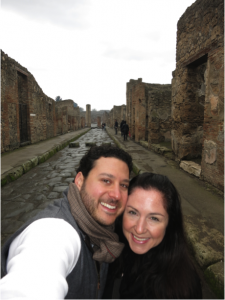 By car, it takes only a few minutes to get to Pompeii. And if you go in winter, like we did, you will find tranquility there among the millennia-old shops, theaters, homes, and alleyways. The January chill keeps the throngs of tourists at bay, so you have entire villas to yourself and empty streets to tease your imagination. Parts of Pompeii are so well preserved that you can imagine the prostitutes with their bleached-white tresses, luring customers to one of the many Pompeiian brothels (more than 30 have been excavated!). You can marvel at the perfect Roman roads that run in a solid grid and try to envision such a smooth path in the ravaged ground of the Roman Forum. You can stand without anyone to block your view and stare at the plaster cast of the chained dog, who guarded his master’s home until the bitter end. Finally, you can grasp with certainty the quality of life enjoyed by Pompeiian inhabitants. What really thrilled me was the thought of the public baths. The baths were nothing new to me, of course, but because of Andrea’s running narration, I recognized their significance. The baths gave even the poorest of Roman citizens a bit of luxury. They also kept people clean and limited the contraction of disease. Looking at the vaulted baths, I could not help but wonder if the human smells in ancient Rome might offend me less than those in some modern cities I’ve visited. I mean, there was sewage in the streets, so that was a real minus, but actual body odor was probably less offensive than you might think – for citizens, at least!
By car, it takes only a few minutes to get to Pompeii. And if you go in winter, like we did, you will find tranquility there among the millennia-old shops, theaters, homes, and alleyways. The January chill keeps the throngs of tourists at bay, so you have entire villas to yourself and empty streets to tease your imagination. Parts of Pompeii are so well preserved that you can imagine the prostitutes with their bleached-white tresses, luring customers to one of the many Pompeiian brothels (more than 30 have been excavated!). You can marvel at the perfect Roman roads that run in a solid grid and try to envision such a smooth path in the ravaged ground of the Roman Forum. You can stand without anyone to block your view and stare at the plaster cast of the chained dog, who guarded his master’s home until the bitter end. Finally, you can grasp with certainty the quality of life enjoyed by Pompeiian inhabitants. What really thrilled me was the thought of the public baths. The baths were nothing new to me, of course, but because of Andrea’s running narration, I recognized their significance. The baths gave even the poorest of Roman citizens a bit of luxury. They also kept people clean and limited the contraction of disease. Looking at the vaulted baths, I could not help but wonder if the human smells in ancient Rome might offend me less than those in some modern cities I’ve visited. I mean, there was sewage in the streets, so that was a real minus, but actual body odor was probably less offensive than you might think – for citizens, at least!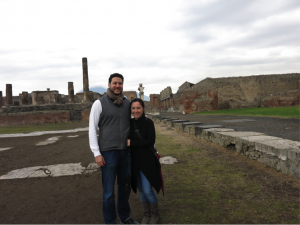 Andrea also pointed out different contraptions and daily devices in the city: the original fast food shops, the public toilets, the stepping stones in the streets to keep you out of flowing filth, etc. He opened my eyes to the many uses of urine, something I didn’t really want to know but that ultimately fascinated me. It turns out that they used urine to tan leather, to dye their hair, to soften wool, as a cleaning agent… it goes on and on! And, he even took us to the urine shop in ancient Pompeii. Although urine isn’t a chief attraction for any of us, we felt like we had an insider’s view into the city. Not to mention the fact that while other tourists poked their noses into maps to try to locate themselves and then plot a route, we literally coasted alone. Andrea knew it all. It was an incredible experience, but it was also efficient – not a moment wasted!
Andrea also pointed out different contraptions and daily devices in the city: the original fast food shops, the public toilets, the stepping stones in the streets to keep you out of flowing filth, etc. He opened my eyes to the many uses of urine, something I didn’t really want to know but that ultimately fascinated me. It turns out that they used urine to tan leather, to dye their hair, to soften wool, as a cleaning agent… it goes on and on! And, he even took us to the urine shop in ancient Pompeii. Although urine isn’t a chief attraction for any of us, we felt like we had an insider’s view into the city. Not to mention the fact that while other tourists poked their noses into maps to try to locate themselves and then plot a route, we literally coasted alone. Andrea knew it all. It was an incredible experience, but it was also efficient – not a moment wasted!
After Pompeii, we drove to Oplontis, simply one excavated home – but such a home. This was possibly the villa of Poppaea, Nero’s wife, whom he perfunctorily killed with a kick to the intestines. 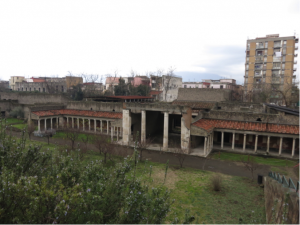 The villa was over 100,000 square feet in its day, perched directly above the sea. It clearly went through a series of owners, as many villas did in Pompeii, as well. However, the frescoes in the most recent additions to the home apparently bear a striking resemblance to those in the Domus Aurea, Nero’s extravagant, elaborate, insane home in Rome. Plus, ancient sources discuss the construction of a home for Poppaea near this site, roughly 10 years before the eruption of Vesuvius. Add all of that to the sprawling size and luxury of the villa, and you know someone of absurd wealth and importance lived here. Oplontis is a quick visit – just about a half-hour – and I hope you can see it with someone who has Andrea’s passion. He shows you how the lines of the villa always point to a gorgeous view and paints glorious pictures in your mind. The frescoes at Oplontis are bright and vivid because they are newly excavated, so those alone are worth a stop. The site is a work in progress; teams of archaeologists from the University of Texas at Austin are working diligently on their Oplontis Project.
The villa was over 100,000 square feet in its day, perched directly above the sea. It clearly went through a series of owners, as many villas did in Pompeii, as well. However, the frescoes in the most recent additions to the home apparently bear a striking resemblance to those in the Domus Aurea, Nero’s extravagant, elaborate, insane home in Rome. Plus, ancient sources discuss the construction of a home for Poppaea near this site, roughly 10 years before the eruption of Vesuvius. Add all of that to the sprawling size and luxury of the villa, and you know someone of absurd wealth and importance lived here. Oplontis is a quick visit – just about a half-hour – and I hope you can see it with someone who has Andrea’s passion. He shows you how the lines of the villa always point to a gorgeous view and paints glorious pictures in your mind. The frescoes at Oplontis are bright and vivid because they are newly excavated, so those alone are worth a stop. The site is a work in progress; teams of archaeologists from the University of Texas at Austin are working diligently on their Oplontis Project. 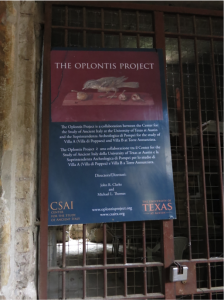 I expect they’ll do a good job of preserving what they find, but you should really come see it because everything we uncover fades with time. This is the newest excavation we have, so it’s a site at its peak.
I expect they’ll do a good job of preserving what they find, but you should really come see it because everything we uncover fades with time. This is the newest excavation we have, so it’s a site at its peak.
Our last stop of the day was at Herculaneum, a site that got a different type of material from the eruption of Vesuvius than Pompeii did. While pumice and large stones and ash buried Pompeii, viscous pyroclastic flows rushed into Herculaneum at lightning speed, filling it in completely and leading to much better preservation of organic materials. At Pompeii, archaeologists found pockets in the compacted volcanic material and filled them in with plaster to find evidence that humans died there during the event. However, no such cavities presented themselves at Herculaneum. No real sign of human life at all in Herculaneum…not until they excavated the arcades that once sat along the shoreline, holding places for boats. In those arcades, researchers found horrific scenes of humans who probably congregated along the beach because of the persistent earthquakes that accompanied the eruptions. During previous earthquakes, that type of maneuver had saved them – but not this time. The skeletons in the arcades are still visible as you approach Herculaneum from above (or at least resin replicas are). The shoreline has moved 500 meters or so away because of the volume of material deposited during the eruption, so you have to use your imagination to visualize the multileveled city towering over the beach. Inside Herculaneum, you’ll see carbonized ropes, beds, doors. You’ll get a peek at intact window glass. You’ll read signs prohibiting patrons from dumping manure into the streets. You’ll see ancient sewage systems. You’ll peer through a shop window to get a glimpse of an ancient iron – it turns out they didn’t like wrinkled togas any more than we would. It was pretty cool. Overall, Herculaneum is a small site. Even at its peak, it probably held 5,000 people. That makes it an easy visit. It should definitely be on your agenda.
As we traveled through Pompeii, Oplontis, and Herculaneum, I felt like the experience was a strange time warp, like I saw a prototype of our own world. No, these ancient Romans didn’t have electricity or motors, but they were far more advanced than our societies were before the Industrial Revolution. In Rome itself, you know that far more elaborate luxuries and technologies existed, but you can’t really see them because Rome itself was consistently inhabited. These sites were frozen in time. Every history buff in the world should see them. To prepare, you should listen to the lectures about Pompeii and Herculaneum. They help you approach the sites with focus and clarity, and they give you the background to ask meaningful questions along the way.
Now, a moment for our meals that day!
Lunch
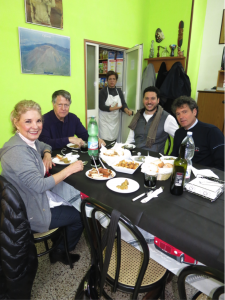 After the visit to Oplontis, Andrea took us for a surprise lunch at the most unassuming café in the world. There is no way on earth I would have known it existed. It’s a small room at the back of a tiny grocery store. There is only one table. There is also only one cook, and she’s a Sicilian grandma who knows everything there is to know about eggplant. She served us incredible food, all homemade. We started with a special bread that’s baked between layers of chopped prosciutto. Then, we moved onto marinated eggplant and the best eggplant/mozzarella pasta of my life. The pièce de resistance was a delicious eggplant parmigiana, and it wasn’t just like mamma used to make – it was what mamma still makes on a daily basis. We finished up with southern European strufoli, a dessert that sort of reminded me of corn pops but seemed to be a major hit with Italians, and creamy Neapolitan cake. All that, plus copious amounts of wine, and our lunch for five (paying for Andrea) was 60 euros, a far cry from the prices of home.
After the visit to Oplontis, Andrea took us for a surprise lunch at the most unassuming café in the world. There is no way on earth I would have known it existed. It’s a small room at the back of a tiny grocery store. There is only one table. There is also only one cook, and she’s a Sicilian grandma who knows everything there is to know about eggplant. She served us incredible food, all homemade. We started with a special bread that’s baked between layers of chopped prosciutto. Then, we moved onto marinated eggplant and the best eggplant/mozzarella pasta of my life. The pièce de resistance was a delicious eggplant parmigiana, and it wasn’t just like mamma used to make – it was what mamma still makes on a daily basis. We finished up with southern European strufoli, a dessert that sort of reminded me of corn pops but seemed to be a major hit with Italians, and creamy Neapolitan cake. All that, plus copious amounts of wine, and our lunch for five (paying for Andrea) was 60 euros, a far cry from the prices of home.
Dinner
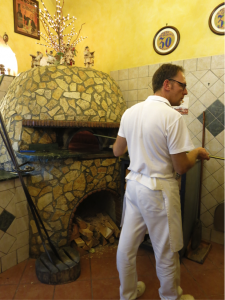 This was one of the great culinary experiences of my life. Andrea recommended a restaurant called Da Attilio, and every pizza lover on earth should go there. On the night we went, the place was packed with locals. We were the only tourists to be found, and the staff took a special liking to us. They seated us right away and treated us like royalty. We ordered two of their specialty pizzas – which are called sole because they resemble the sun. These masterpieces have their outsides folded over to make eight points, each of which oozes fresh ricotta cheese. Then, the centers burst with their toppings of either tomato and mozzarella or yellow tomatoes and porcini mushrooms. The pizzas were literally insane. I got the pappardelle with fresh porcini, but I could hardly restrain myself from Jamil’s and my dad’s pizzas. Those pizzas were absolutely addictive and enchanting. I am so glad I don’t live in Naples. I would have to eat there all the time. No amount of walking could burn that off.
This was one of the great culinary experiences of my life. Andrea recommended a restaurant called Da Attilio, and every pizza lover on earth should go there. On the night we went, the place was packed with locals. We were the only tourists to be found, and the staff took a special liking to us. They seated us right away and treated us like royalty. We ordered two of their specialty pizzas – which are called sole because they resemble the sun. These masterpieces have their outsides folded over to make eight points, each of which oozes fresh ricotta cheese. Then, the centers burst with their toppings of either tomato and mozzarella or yellow tomatoes and porcini mushrooms. The pizzas were literally insane. I got the pappardelle with fresh porcini, but I could hardly restrain myself from Jamil’s and my dad’s pizzas. Those pizzas were absolutely addictive and enchanting. I am so glad I don’t live in Naples. I would have to eat there all the time. No amount of walking could burn that off.
Naples Hotel: La Ciliegina Lifestyle Hotel
We’ve established that many tourists have a hard time with Naples, so it shouldn’t surprise you that five star hoteliers are reticent to invest in sweeping properties there. In my experience, four star hotels are often sketchy, especially if they’re big. I would much rather stay at a three star with a good reputation than a four star that earned its ratings 30 years ago. If you do stay at a four star, make sure you’ve read a ton of reviews on TripAdvisor and browsed reputable travel sites, like Frommer’s and Fodor’s. I know that sounds strange, but it’s the reality in Southern Europe. Believe me.
La Ciliegina is a four star that I researched repeatedly. It doesn’t have the seaside location that some other four stars do, but it received rave reviews for its cleanliness and service. At less than $130 per night, I figured our risks were low. Luckily, it was absolutely charming – with one major exception: they need to tone down the air freshener. We never could air it out. Yes, it’s a better smell than the smoke they were probably trying to mask, but it was intense, too intense for me. However, the service was perfect. The location was great. The rooftop sitting area was a bonus. I would stay there again, but I would call in advance and ask for a room with no air freshener!
An Educational Trip – Naples Day 1
First day in Naples
We took an early train out of Rome. Well, for us it was early. We departed at 10:35, sharp. I had many reservations about this Naples stay. I didn’t want to visit Naples at all. The rumors were bad: Naples was not only rough but also ugly. A useless stop on a well-planned tour of Europe’s best. In fact, I even tried to stay in Sorrento – but it made no sense; everything was closed. All I could do was suck it up and subject my family to the dangerous ills of this forgotten city of disrepair.
People lie. They lie about their age. They lie about their weight. They lie about their past, their present, their future…Why should it surprise me that they also lie about Naples?
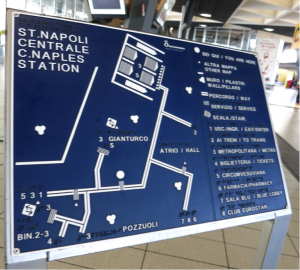 Naples is a gem. It stands proudly alongside the eponymous Bay of Naples, rising along a hillside that is organically and integrally connected to the city itself. Naples has a history that outstrips that of Rome (as a geographical location) and monuments that could make Florence sigh. However, as a port city between Civitavecchia and the Amalfi Coast with a Mafioso heritage, Naples has gained an inglorious reputation as an outdated outpost for outlaws. Furthermore, with its lack of industry and resistance towards modernization, this town of clotheslines and fishmongers feels distinctly anachronistic. If you are looking for a McDonald’s, you can certainly find one, but it won’t be flashing its golden arches in your face. For this is a city of pizza, not Happy Meals. And it’s loaded with culture, if you can erase your preconceptions of what culture means. FYI, it does not mean frozen in time or Disney-esque. Culture means a way of life, reality, inhabitation, evolution, elasticity, blood flow. Naples has it all.
Naples is a gem. It stands proudly alongside the eponymous Bay of Naples, rising along a hillside that is organically and integrally connected to the city itself. Naples has a history that outstrips that of Rome (as a geographical location) and monuments that could make Florence sigh. However, as a port city between Civitavecchia and the Amalfi Coast with a Mafioso heritage, Naples has gained an inglorious reputation as an outdated outpost for outlaws. Furthermore, with its lack of industry and resistance towards modernization, this town of clotheslines and fishmongers feels distinctly anachronistic. If you are looking for a McDonald’s, you can certainly find one, but it won’t be flashing its golden arches in your face. For this is a city of pizza, not Happy Meals. And it’s loaded with culture, if you can erase your preconceptions of what culture means. FYI, it does not mean frozen in time or Disney-esque. Culture means a way of life, reality, inhabitation, evolution, elasticity, blood flow. Naples has it all.
We weren’t familiar with the town, however, so we hired a guide. Yes, I know, this is getting to be a pattern for us, but we don’t have all the time in the world here. We don’t have time to read, visit, reread, and revisit. We have to get it all done in one fell swoop. A guide lets us do that. A great guide helps us bypass the fluff and cut to the core of the experience. Luckily, in Naples, we contacted the Mondo Guides agency, which scheduled our visit with the dashing Andrea Ruggiero.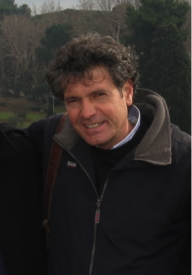
Andrea possesses a palpable passion for Naples. Although he hails originally from Sorrento, this is a man who has grown up in the shadow of Vesuvius, a Neapolitan through and through. He started us off with a ride on the metro of Naples, a modern wonder. The metro of Naples might go overlooked by many cruise-ship tourists, but it’s been recognized by the entire EU for its genius construction. It’s a work of modern art all unto itself. Andrea pointed out the three levels or construction – the yellow level of tuff that represents the city of the ancients down to the blue level of the sea, which the city had to drain arduously in order to create the metro itself. The metro contains gorgeous mosaics that make you ask yourself if the eventual inhabitants of the eventual earth will discover them and try to interpret our position, our perspective, and our prowess. Without such a masterful guide, there is NO WAY we would have gone into the metro. And that’s just the beginning.
From there, we went to the Naples Archaeological Museum, an international treasure that houses the finest finds from Pompeii and Herculaneum. While I could go on for eternity about what we saw in the museum, I’ll instead tell you the harsh truth: Even an archaeology buff like me could not possibly have navigated that sea of antiquities alone. There is simply too much to see, too much to process, too much to contextualize. A guide helps you see the highlights, but he/she also gives insight into relics that might otherwise seem flat and meaningless.
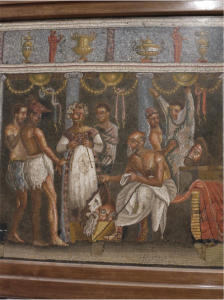 With Andrea’s narration, we did more than observe antiquities; we interacted with them. Rather than tell us the art’s meaning, Andrea encouraged us to make our own interpretations. In doing so, he acknowledged that no matter how closely scholars examine the findings and no matter how much background they have to make informed conclusions, archaeology is not an exact science. Interpretations change, and people perceive differently. Therefore, the remnants of Roman daily life left behind in Pompeii and Herculaneum are yours to view how you wish.
With Andrea’s narration, we did more than observe antiquities; we interacted with them. Rather than tell us the art’s meaning, Andrea encouraged us to make our own interpretations. In doing so, he acknowledged that no matter how closely scholars examine the findings and no matter how much background they have to make informed conclusions, archaeology is not an exact science. Interpretations change, and people perceive differently. Therefore, the remnants of Roman daily life left behind in Pompeii and Herculaneum are yours to view how you wish.
In addition to that necessary stop into the museum, we strolled through the streets of Naples, the only city that retains its original city plan. Naples was never completely rebuilt or redesigned, unlike other Italian cities, such as Rome and Florence. Therefore, it remains a hive of tenements, all arranged on a planned Greek grid (Naples was founded by the Greeks as the Nea Polis, or new city, which is where we get Neapolitan). The streets are extremely narrow, giving the city a closeness that grand, wide avenues eradicate. Naples is also a hodgepodge of life; the very rich and very poor live on top of one another, sharing a common character, if not a common standard of living. We punctuated our walk through the Neapolitan maze with visits to chapels and churches, learning all about the Sansevero noble who built the elaborate, awe-inspiring Sansevero Chapel that houses the Cristo Velato – the Veiled Christ. Andrea pointed out the Masonic elements in the chapel and explained the public reaction to sculptures so impossibly lifelike. He took us into the bowels of the chapel to see evidence of the medical experimentation that Sansevero conducted, as well as informed us of Sansevero’s role in creating the first raincoat. It was one wonder after another, simply nonstop.
That night, we drove up into the hills that overlook the Bay of Naples to see the ancient Roman port from a distance and observe the same waters that have attracted visitors and worshipers for millennia. I could almost see Pliny the Elder, boating across the bay, pelted by pumice, trying to get a closer view of Vesuvius – and ultimately suffocating from the gases. So many famous historical figures have peered out at those same waves that I felt an overwhelming intimacy with the past in a way I rarely have in Rome. Perhaps it was the wintry timing of our visit, which practically emptied the harbor, but I felt like we had a pristine view all to ourselves, unmarred by grossly oversized cruise ships and undisturbed by hordes of fanny pack-toting tourists.
By the time Andrea dropped us back at the hotel, it was with an excellent dinner recommendation and a promise to meet us bright and early the next morning for a full day of immersion in Roman history at the sites of Pompeii, Herculaneum, and Oplontis.
An Educational Trip – Celebrating New Year’s in Athens
New Year’s in Athens
After spending two separate New Year’s Eve celebrations in Athens, I feel somewhat able to offer advice for how to ring in the event. First, you should note that the city is lively on New Year’s Eve, but it’s not insane. It’s not like trying to book the impossibly sought-after reservation in New York City or Paris. Nor is it a city of the fixed price soirees that we found in Barcelona and Banff. On the contrary, Athens is a casual city of locals who want to ring in the New Year with family and friends, but without excessive pomp and circumstance. That said, the Grande Bretagne, where we stayed on this past trip, offered two very high-dollar options, one in the beautiful downstairs tearoom and another in the glass-enclosed aerie of the rooftop bar. They were between 250 and 380 euros per person, and we just couldn’t rationalize spending that much on a menu that looked less than appealing, especially when we’re hardly people to party until the wee hours and truly appreciate the planned festivities.
This year’s upscale experience:
To decide upon a place, we articulated what mattered to us: a great view of the fireworks over the Acropolis, terrific food a la carte, and some measure of glamour. After a great deal of research, we decided upon Strofi, a highly acclaimed restaurant right behind the new Acropolis Museum.
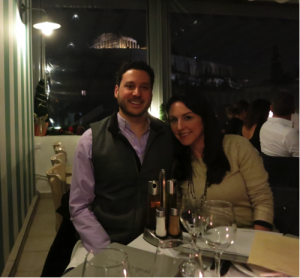 I have to admit, I was worried. I couldn’t tell if the rave reviews were overstated, perhaps written by pedestrian tourists who would praise any old dolma or saganaki. But I decided we would brave it. It turned out to be fabulous, absolutely one of our best New Year’s experiences ever – and that’s really saying something because we have made some pretty wonderful December 31st memories (but that’s another post). We had a perfect view of the Acropolis, and although the Greek government doesn’t have the money for an American-style firework extravaganza, the spectacle is emblazoned in my mind as a glorious combination of the ancient and the modern. We popped a bottle of good champagne and listened to the Greeks sing some happy, traditional songs. There were no downsides to this meal or to the restaurant itself. We would go back without hesitation.
I have to admit, I was worried. I couldn’t tell if the rave reviews were overstated, perhaps written by pedestrian tourists who would praise any old dolma or saganaki. But I decided we would brave it. It turned out to be fabulous, absolutely one of our best New Year’s experiences ever – and that’s really saying something because we have made some pretty wonderful December 31st memories (but that’s another post). We had a perfect view of the Acropolis, and although the Greek government doesn’t have the money for an American-style firework extravaganza, the spectacle is emblazoned in my mind as a glorious combination of the ancient and the modern. We popped a bottle of good champagne and listened to the Greeks sing some happy, traditional songs. There were no downsides to this meal or to the restaurant itself. We would go back without hesitation.
The more earthy experience of 2 years ago:
When Jamil and I went as a twosome, we were looking for the nitty-gritty New Year’s Eve of the Athenian people. We went out around 11:30 and perused the streets of Monastiraki (possibly a dangerous choice, but we were keeping a low profile). All of the restaurants were packed with families and couples, with solitary musicians strumming guitars and singing folk songs. We selected a small restaurant on the corner of Ermou Street, called Dipylo. There were people of all ages, and they literally smoked and partied until the sun came up. I remember eating a simple Greek meal that night, nothing fancy, and drinking Greek table wine. However simple the fare, we were surrounded by an element of authenticity that I have rarely experienced on New Year’s Eve. In fact, you’d be hard pressed to find such an opportunity in a snootier European city. Athens is, for at least a little while longer, a forgotten paradise.
Copyright 2022 , All-in-One Academics
info@allinoneacademics.com


